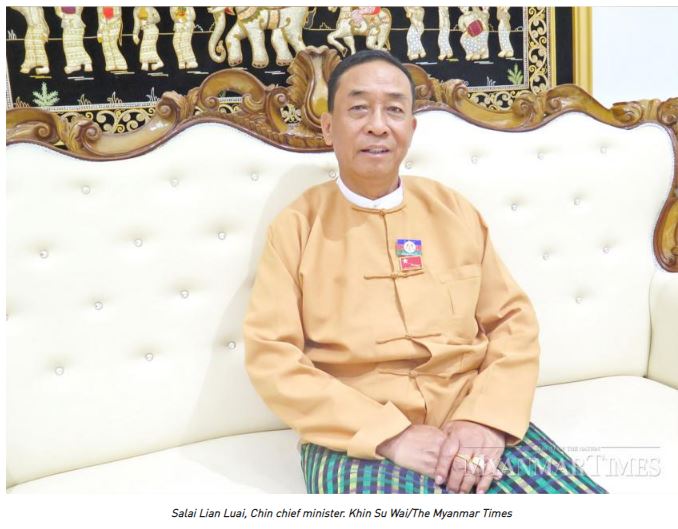Myanmar: Investment opportunities available in Chin State power, transportation sectors: chief minister
Salai Lian Luai, Chin chief minister, sees big opportunities for growth and returns for investors willing to channel funds into the state. Besides hotels and tourism, Chin, he said, requires large investments in infrastructure such as roads and power grids to draw a higher volume of tourists and connect the state to rest of the country.
Owing to its difficult and mountainous terrain, Chin State is one of the poorest states in Myanmar with the least investment. Yet, it is also the most scenic. In Chin, the most successful sectors are hotels and tourism because of the scenery and attractions such as Nat Ma Taung National Park, Reeds Lake and Kanpatlat township, which is home to the famed Mount Victoria.
“Chin State is also a very peaceful state. Chin people even take delight in offering visitors the food they have. They are a very united people and enjoy their traditional dances. Local as well as foreign businesses are invited to invest in any sector they desire in Chin State. As there are currently not many investments there yet, it’s a good time for investors to gain the first mover advantage in Chin,” Salai Lian Luai told The Myanmar Times during an exclusive interview in Mandalay, where he visited this week.
Here is an excerpt of our interview:
Where are the opportunities and challenges for investors in Chin State?
The opportunities are in hotels and tourism, fruit and vegetable plantations and livestock farms. There are some barriers in land use – if land is owned by residents or ancestral land, negotiations between the government and private business are necessary before making investments. When the government grants vacant or fallow land for private business we need to make sure residents won’t oppose. There may be some difficulties because permission from residents is needed also.
What sectors are seeing investor interest now?
Investments have entered mostly into the agriculture and livestock sectors. Foreign investments are being facilitated by the UK’s Dana Facility. After forming the Chin State Investment Commission, we have been able to automate certain tasks such as peeling yams and grinding meats in factories, which were not possible before.
What kind of infrastructure is most needed?
There are many infrastructure requirements. The hilly terrain is very suitable for hydropower projects. Big companies are coming to do it. I invite both local and foreign investors to come and carry out field studies and invest.
So far, we have found 27 places in which 30-megawatt projects can be carried out. There are also several locations on the Manipur River where 300-megawatt and 600-megawatt hydropower projects are feasible. A total of ten companies from India, Norway, China, the Netherlands and Japan have already conduced feasibility studies and we have signed six MOUs with the likes of the Union Government, Power China Company, Norway Power Company and other local companies.
Is the power supply a big problem?
We don’t have sufficient power supply yet. The national grid only reaches four townships including Mindat and Kanpetlet and some villages near them. Arrangements are being made at the Union level to provide electricity in Tiddim and Matupi using state funds. One challenge is that the regions and states can only authorise power projects under 30 MW. Those above 30 MW can only be carried out by the Union government.
The other problem is although we have permission for projects under 30 MW, we can’t decide on the electricity price. Only the Union government can make those decisions. The process will be smoother and faster if some of these decisions could be made at the regional and state level.
What are the transportation challenges?
Chin State is the hardest-to-reach region in Myanmar. After three years in power, the current government has helped to pave a road of a distance of more than 500 miles to connect between the southern and northern part of Chin State all year round. In the past, to travel from Hakha to Paletwa, we reach there only after passing nearly five regions and states. Now, we can go there directly. Things have developed over the past few years.
Is there any policy or strategy to increase the number of investment and economic opportunities in Chin State?
A total of 13 sectors are being prioritised based on the government’s investment policy and strategy. These include hotels and tourism, fruit and vegetable plantations and farming. Now, certain areas are electrified and so we expect to produce tin.
We are now exporting fruits, meat and fish to India. They purchase all that we currently sell. To scale this we will need more electricity and the Manipur-Mizoram Bridge to connect us to the Indian border, so that we can export as much as we want. Construction of the bridge will start this year with support from India.
An airport in Falam Township of Chin State is also underway, and it is expected to open it in May 2020.
Meanwhile, education and healthcare are making much faster progress. I believe we will see a lot of growth take place in Chin over the next two years.
Source: https://www.mmtimes.com/news/investment-opportunities-available-chin-state-power-transportation-sectors-chief-minister.html


 English
English




